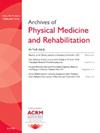针对脊柱侧凸的理疗运动对青少年特发性脊柱侧凸患者三维脊柱畸形的疗效:系统回顾和荟萃分析。
IF 3.6
2区 医学
Q1 REHABILITATION
Archives of physical medicine and rehabilitation
Pub Date : 2024-12-01
DOI:10.1016/j.apmr.2024.04.011
引用次数: 0
摘要
目的研究物理治疗脊柱侧凸专项运动(PSSE)对青少年特发性脊柱侧凸(AIS)患者脊柱冠状面、水平面和矢状面畸形的影响,以及曲线严重程度、干预持续时间和干预类型如何改变这些影响:数据来源包括PubMed、Web of Science、Embase、Cochrane Library和Scopus数据库,检索时间从开始到2023年9月5日:报告 PSSE 对 10 至 18 岁 AIS 患者的 Cobb 角、躯干旋转角 (ATR)、胸椎前凸 (TK) 或腰椎前凸 (LL) 的影响的临床对照试验。实验组接受 PSSE;对照组接受标准护理(观察或支撑)或常规锻炼,如核心稳定锻炼、普拉提、PNF 和其他非特异性锻炼:两名研究人员独立从符合条件的研究中提取关键信息。研究质量采用 Cochrane 手册 5.1.0 版偏倚风险评估和 JBI 循证医疗保健中心(2016 年)准实验研究真实性评估工具进行评估。证据的水平和确定性根据建议评估、发展和评价分级(GRADE)框架进行评定。我们遵循了《系统综述和荟萃分析首选报告项目》(Preferred Reporting Items for Systematic Reviews and Meta-Analyses)声明。本研究的方案已在 PROSPERO(CRD42023404996)上注册:分别对 12 项随机对照试验(RCT)和 5 项非 RCT(NRCT)进行了元分析。结果表明,与其他非手术疗法相比,PSSE能显著改善Cobb角、ATR和TK,而LL的改善在统计学上并不显著。此外,与对照组相比,PSSE 对曲线严重程度≥30°的患者的 Cobb 角疗效不明显。尽管如此,PSSE对Cobb角的综合疗效并未因干预持续时间和干预类型而发生显著变化,对ATR的疗效也未因干预持续时间而发生显著变化。根据 GRADE,RCT 的总体证据质量为中低,NRCT 为极低:结论:与其他非手术疗法相比,PSSE 对 AIS 患者的 Cobb 角、ATR 和 TK 均有积极疗效。此外,PSSE 的有效性可能与干预持续时间和干预类型无关,但可能受初始 Cobb 角的影响。然而,未来需要更多的 RCT 来验证 PSSE 对平均 Cobb ≥30° 的中度 AIS 的疗效。目前的证据因对照组干预措施不一致和研究样本量较小而受到限制。本文章由计算机程序翻译,如有差异,请以英文原文为准。
Effectiveness of Physiotherapeutic Scoliosis-Specific Exercises on 3-Dimensional Spinal Deformities in Patients With Adolescent Idiopathic Scoliosis: A Systematic Review and Meta-analysis
Objective
To investigate the effects of physiotherapeutic scoliosis-specific exercises (PSSE) on coronal, horizontal, and sagittal deformities of the spine in adolescent idiopathic scoliosis (AIS) as well as how curve severity, intervention duration, and intervention type could modify these effects.
Data Sources
Data sources included PubMed, Web of Science, Embase, Cochrane Library, and Scopus databases, which were searched from their inception to September 5, 2023.
Study Selection
Clinical controlled trials reporting the effects of PSSE on the Cobb angle, angle of trunk rotation (ATR), thoracic kyphosis (TK), or lumbar lordosis in patients with AIS aged 10-18 years. The experimental groups received PSSE; the control groups received standard care (observation or bracing) or conventional exercise such as core stabilization exercise, Pilates, proprioceptive neuromuscular facilitation, and other nonspecific exercises.
Data Extraction
Two researchers independently extracted key information from eligible studies. The quality of the studies was assessed using the Cochrane Handbook version 5.1.0 risk of bias assessment and the JBI Center for Evidence-Based Health Care (2016) of quasi-experimental research authenticity assessment tool. The level and certainty of evidence were rated according to the Grading of Recommendations, Assessment, Development, and Evaluation framework. We followed the Preferred Reporting Items for Systematic Reviews and Meta-Analyses statement. The protocol for this study was registered in PROSPERO (CRD42023404996).
Data Synthesis
Twelve randomized controlled trials (RCTs) and 5 non-RCTs were meta-analyzed separately. The results indicated that compared with other nonsurgical management, PSSE significantly improved the Cobb angle, ATR, and TK, whereas the lumbar lordosis improvement was not statistically significant. Additionally, the efficacy of PSSE on Cobb angle was not significant in patients with curve severity ≥30° compared with controls. Nevertheless, the pooled effect of PSSE on Cobb angle was not significantly modified by intervention duration and intervention type and that on ATR was not significantly modified by intervention duration. The overall quality of evidence according to Grading of Recommendations, Assessment, Development, and Evaluation was moderate to low for RCT and very low for non-RCT.
Conclusions
PSSE exhibited positive benefits on the Cobb angle, ATR, and TK in patients with AIS compared with other nonsurgical therapies. In addition, the effectiveness of PSSE may be independent of intervention duration and intervention type but may be influenced by the initial Cobb angle. However, more RCTs are needed in the future to validate the efficacy of PSSE in moderate AIS with a mean Cobb angle ≥30°. Current evidence is limited by inconsistent control group interventions and small sample size of the studies.
求助全文
通过发布文献求助,成功后即可免费获取论文全文。
去求助
来源期刊
CiteScore
6.20
自引率
4.70%
发文量
495
审稿时长
38 days
期刊介绍:
The Archives of Physical Medicine and Rehabilitation publishes original, peer-reviewed research and clinical reports on important trends and developments in physical medicine and rehabilitation and related fields. This international journal brings researchers and clinicians authoritative information on the therapeutic utilization of physical, behavioral and pharmaceutical agents in providing comprehensive care for individuals with chronic illness and disabilities.
Archives began publication in 1920, publishes monthly, and is the official journal of the American Congress of Rehabilitation Medicine. Its papers are cited more often than any other rehabilitation journal.

 求助内容:
求助内容: 应助结果提醒方式:
应助结果提醒方式:


